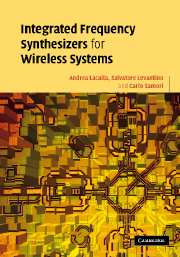6 - Reactive components in oscillators
Published online by Cambridge University Press: 09 August 2009
Summary
Introduction
The key impact of reactive elements on VCO performance has been highlighted extensively in the preceding chapters. Noise, tuning range, signal amplitude and power dissipation are all strongly dependent on the ‘quality’ of inductors and variable capacitors. This chapter is, therefore, devoted to discussing the margin left to the designer for judiciously tailoring these components to squeeze out the best performance.
The optimization of reactive elements is not fully under the control of the circuit designer. Some properties depend directly on the process and often the only option left to the designer is to choose the inductor geometry or the varactor type, within a limited library of components that have previously been characterized and modelled.
On the other hand, a larger degree of freedom would call for a full customization of the reactive components, which is a very risky and delicate process, involving some trial-and-error steps, starting from numerical modelling at the device level, and proceeding with its experimental characterization, the fine tuning of the structure and the development of compact models for circuit simulation.
However, the increase in operating frequency is making the optimization of reactive components a key ability of an RF designer. The following sections give some basic guidelines.
Integrated inductors
On-chip inductors
On-chip inductors are widely used in silicon-based RF integrated circuits as series or shunt elements in resonant VCO tanks, as well as impedance-matching elements in LNAs and choke components. Inductors have traditionally been integrated in GaAs MMICs.
Information
- Type
- Chapter
- Information
- Integrated Frequency Synthesizers for Wireless Systems , pp. 133 - 156Publisher: Cambridge University PressPrint publication year: 2007
